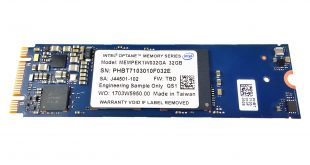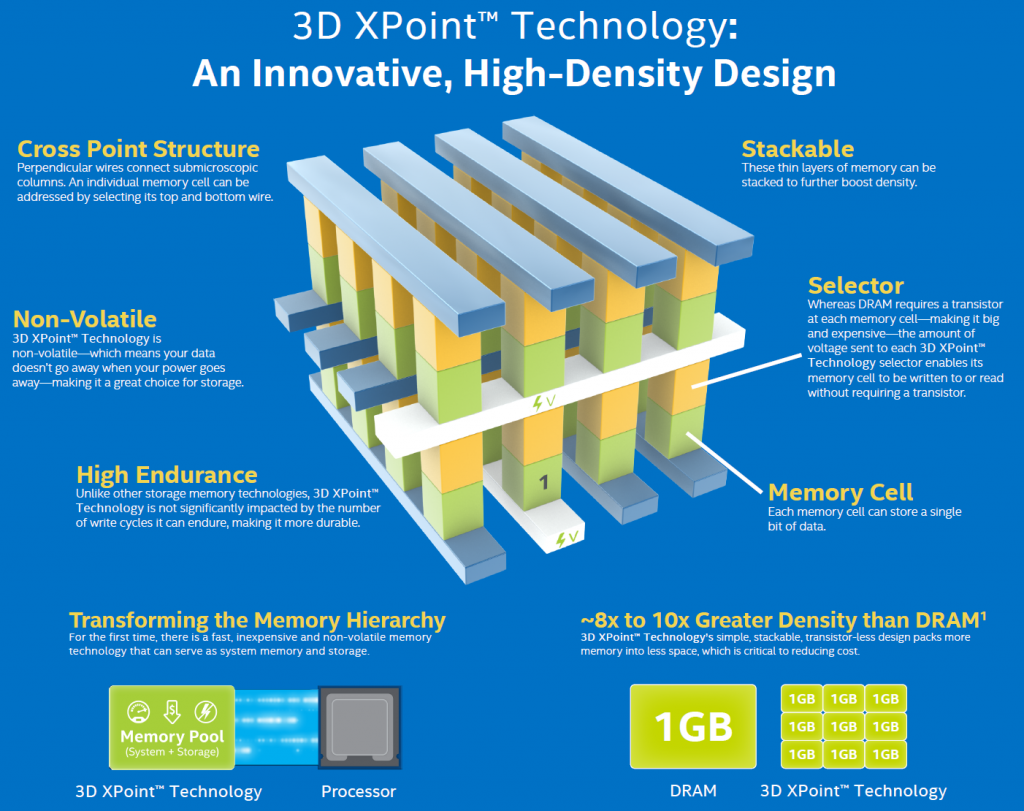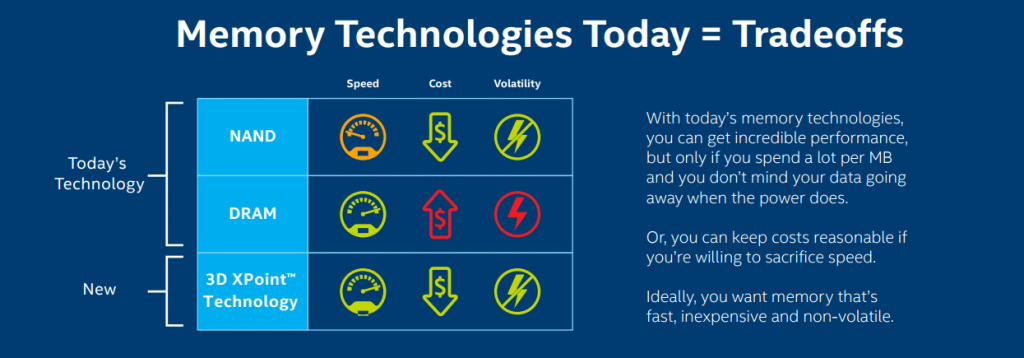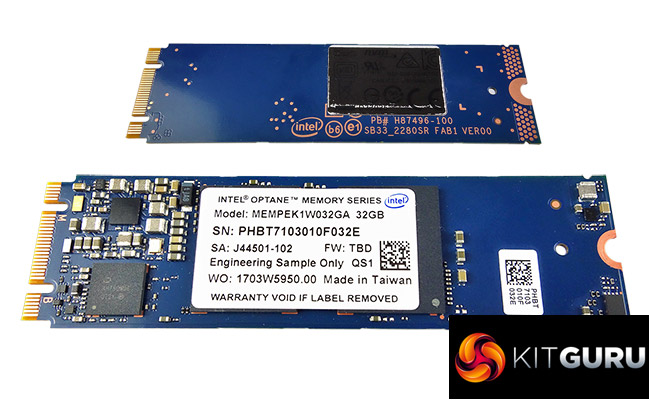
Optane is Intel's brand name for their 3D XPoint memory technology. The first Optane product to break cover was the Optane PC P4800X, a very high-performance SSD aimed at the Enterprise segment. Now we have the second product using the technology, this time aimed at the consumer market segment – the Intel Optane Memory module.
The Optane Memory module is built on a 2280 M.2 format using a PCIe 3.0 x2 interface, not the usual x4 PCIe 3.0 interface that the latest M.2 PCIe drives use. Intel quote Sequential Read performance for the 32GB Optane Memory module as 1,350MB/s, which is very impressive. Not nearly as impressive is the official Sequential write figure of just 290MB/s. Random 4K performance for the drive is quoted as up to 240,000 IOPS for reads and 65,000 IOPS for writes.
Endurance for the 32GB module is quoted as 185.5TB which works out around 100GB/day. Intel back the Optane Memory module with a 5 year warranty.
A clue as to what Intel sees the Optane Memory module being used for is that the device is only available in 16GB and 32GB versions. Although they can be used as boot drives at a pinch, Intel has another plan for the Optane Memory module. That is to blow the dust off an old idea to have another crack at trying to get the consumer market interested in the technology that is SSD caching.
Intel have been plugging away at SSD caching – combining a flash based device with a standard HDD to produce fast performing, large capacity storage sub systems for a very long time. Trying to persuade the consumer market that it's a technology worth pursuing has not been an easy sell by any stretch of the imagination.
Now that might well be set to change with the Optane Memory module, which offers the performance that was missing from previous attempts with the technology. That is all well and good but in the time frame it’s taken to get to this point, the consumer SSD market has been involved in a frantic price war which has seen the price of consumer SSDs drop to a level where 120GB or 240/250GB class drives are at a price point unimaginable even two years ago, making very fast primary storage easily obtainable.
3D XPoint

Jointly developed with Micron since 2012, Intel's 3D XPoint is the first new class of memory technology since Flash NAND was introduced in the early eighties. It has been designed to provide extremely fast, very low latency, high capacity storage devices and it has the potential to revolutionise the way we look at both system memory and storage systems as it has been designed, ultimately, to serve both areas.

3D XPoint sits between DRAM and NAND in terms of performance. Theoretically, 3D XPoint can work 100–1000 times faster than NAND, although for the time being current storage interfaces will put a limit on this advantage. The new memory is some 8-10 times denser than DRAM, which gives it a keen cost advantage over the older technology and has another major advantage over DRAM in that it is non-volatile.

The new memory is also much more durable than Flash NAND as 3D XPoint writes are, unlike Flash writes, non-destructive which should bring drives that far outstrip current Flash NAND technology endurance rates.
Physical Specifications:
Usable Capacities: 16GB, 32GB
NAND Components: 128Gb 20nm 3D XPoint
Interface: PCIe 3.0 x2
Form Factor: M.2 2280
NAND Controller: Intel
Dimensions: 22 x 80mm
Firmware Version: K3110300
 KitGuru KitGuru.net – Tech News | Hardware News | Hardware Reviews | IOS | Mobile | Gaming | Graphics Cards
KitGuru KitGuru.net – Tech News | Hardware News | Hardware Reviews | IOS | Mobile | Gaming | Graphics Cards




LMAO testing 4k results at QD32.. wtf. common kitguru, on page 4, optane module is to accelerate 4k at low QD. tell me that a consumer would run 32 parallel things at once. i understand its not good to be biased and show the bad side, the other side is also true its not good to not test what the thing is intentionally made for, which is to accelerate low QD in 4k vs SSDs
FFS, Intel was working on this for ages. From a consumer point of view Optane is useless (the enterprise drive which predated this made perfect sense). Honestly, I just don’t understand why PCIe x 2, why 32GB max – there’s plenty enough room on that board for at least 128GB. My gran (and her dog) already have a 512 or a 1TB boot drive. Consumers just don’t notice QD performance. And I’m about to buy an AMD in September. Consumer products that could have been used in various ways, but cannot, make me wander whether Baldrick was cunningly involved in development.
The problem with tests of disk caching is that they tend not to reflect real world usage, which is what consumers would care about. I’ve seen it with SSHD, which tends to show speedups over HDD, but when you have them in a real PC that runs tons of stuff at startup, has lots of software and games and media installed, it doesn’t really seem to provide much benefit.
So the question is, how well does Optane work on an “old” system compared to an SSD for system plus HDD for media/games and compared to just the HDD without caching? That’s what I’d like to know.
You cant even test it on a old system since it only works on kaby lake cpu and mobos
I guess intel is trying to explore new ways to make a living now that Ryzen has launched lol, what next? Intel burger outlets and clothing lines?
I have to say for home users, even those who do more demanding tasks I cant see why speeding up the read from a slow hard drive (but only for the first 32 gb) will make that much of a difference as even basic systems use an SSD for the OS and applications and mid to high PCs tend to be using NVMes like the Evo 960
So the mechanical hard drive is mostly for just storing files anyway, and theres no advantage to speeding up a video file that cant saturate the drive to begin with
For enterprise applications I can see benefits with the latency but not really “feeling” why home users should buy this or even content producers tbh due to the large difference between read and write, as theres no point being able to read a video you are converting at a faster speed if you cant also write it at that same higher speed. Its like converting the first half of a road into 8 lanes but leaving the second half at only 2
But its a new technology and will certainly be worth watching over the next couple of years to see how it develops
But for the foreseeable future I cant see any reason to move away from my current three drive model with an NVMe OS/large app/intensive games drive, SSD for secondary apps and games and a mechanical for subsequent storage for larger files like films and music which don’t need speeding up to begin with for watching, and having just the first 32gb read faster for backing up etc isn’t really that much of an advantage, less so if the files aren’t already cached
I dont know why you test a product in a way that no where made for. Optane purpose is caching only. If i want an ssd i go for samsung m.2 960. I dont see any reason to put an OS in only 32GB. I would like to see how windows perform in real world with Optane + HD or Optane + SDD, game loading and heavy program loading test.
What? it’s just incrementally improving Intel SRT which has been on zx70 chipset boards long before Razen came out.
That’s not true. Intel SRT improves system boot and game start up times very significantly.
Is it as fast as a SSD? Probably not. However, many games are GB these days and many gamers have 1 or 2TB drives to store a lot of games. Caching these works.
I’ve used Intel SRT with a cheap 64gb SSD, half of which is used to cache a 2tb drive (the other half I have TF2 installed on because that’s the game I play most often)
And it’s a noticeable speed up. The only downside I’d say with SRT is that there’s no system statistics. Intel’s “rapid storage technology” software, which is used to configure and enable the caching, doesn’t tell you how much data is in the cache, what the hit/miss rate percentages are etc. This is something that they really should have implemented by now.
As it is, SRT is more noticeable when you disable it for some reason. If you do, rebooting your PC or switching maps or levels in a game you’ve been playing frequently seems to take an age and you realise how much benefit it gave you.
Obviously it’s not as big a gain as installing everything on SSD, but neither is it anywhere near the cost. If you’re buying a Zx70 board anyway, to get the overclocking etc on the K chips, you’re getting the feature. Why not use it?